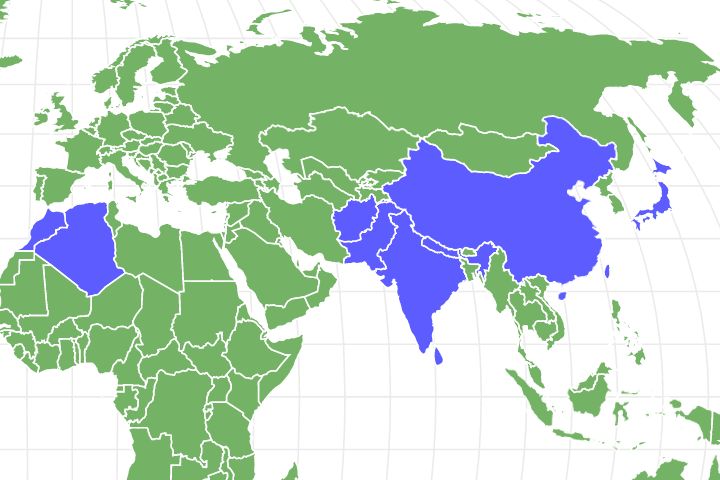Macaque
Macaca
Macaque females will pass on their social rankings to their daughters
Advertisement
Macaque Scientific Classification
- Kingdom
- Animalia
- Phylum
- Chordata
- Class
- Mammalia
- Order
- Primates
- Family
- Cercopithecidae
- Genus
- Macaca
- Scientific Name
- Macaca
Read our Complete Guide to Classification of Animals.
Macaque Conservation Status
Macaque Facts
- Prey
- Fruits, seeds, leaves, flowers, bark, and insects
- Name Of Young
- infant
- Group Behavior
- Troop
- Fun Fact
- Macaque females will pass on their social rankings to their daughters
- Estimated Population Size
- varies
- Biggest Threat
- Habitat loss
- Most Distinctive Feature
- The long hair around the muzzle
- Other Name(s)
- Cynomolgus
- Gestation Period
- 5-6 months
- Litter Size
- 1
- Habitat
- Plains, mountains, and rainforests
- Predators
- Tigers, crocodiles, snakes, leopards, and birds of prey
- Diet
- Carnivore
- Average Litter Size
- 1
- Type
- mammal
- Common Name
- Macaque
- Number Of Species
- 20
- Location
- Asia and North Africa
View all of the Macaque images!
Clever, social, and highly intelligent, the macaque is among the most common primates in the world.
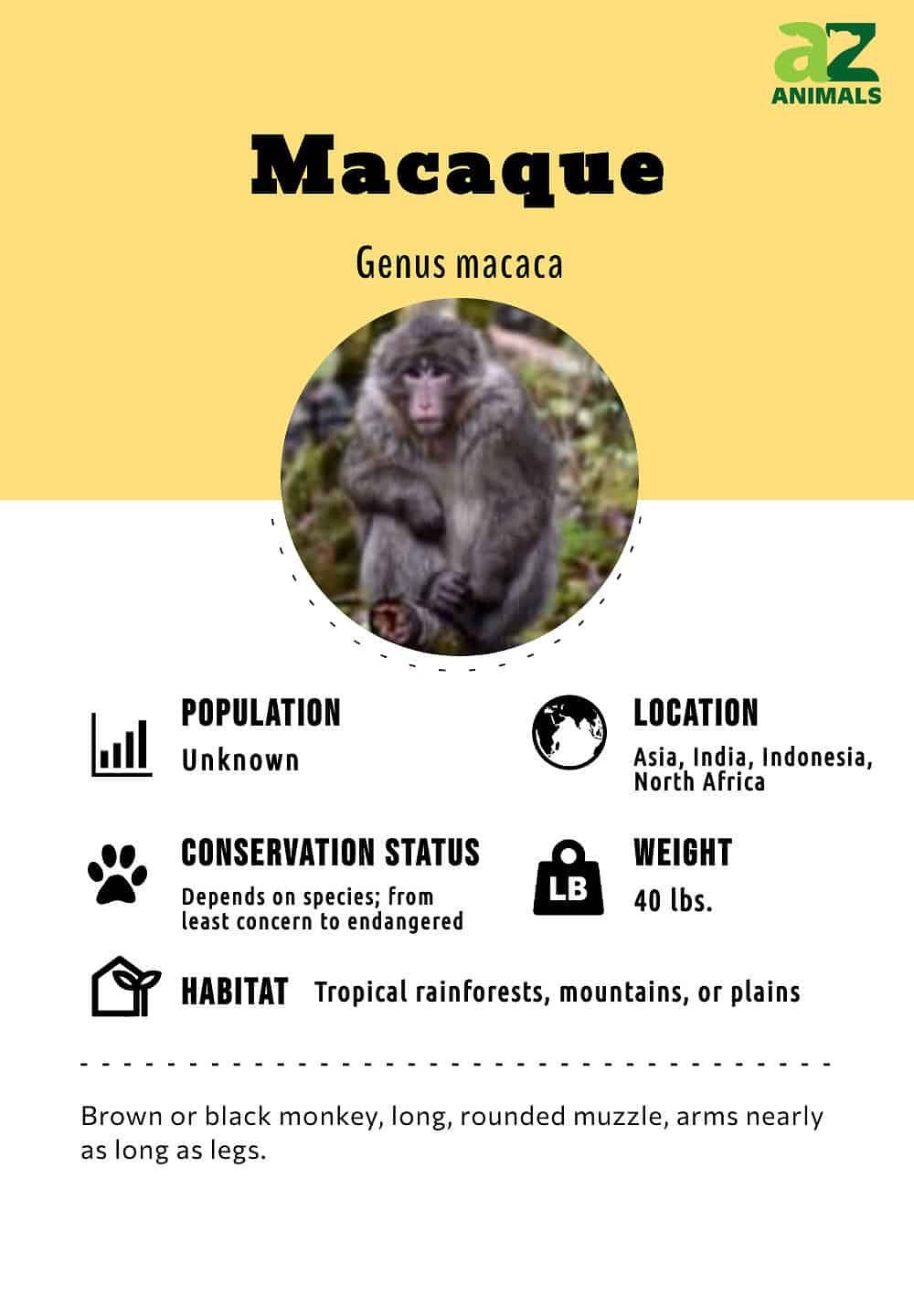
The macaque is a genus of more than 20 Old World monkeys (meaning monkeys that originated from the Eastern Hemisphere). These are naturally charismatic primates with very complex behaviors and social structures. Many species have learned to live near and around humans, resulting in frequent interactions. Some of the most well-known species include the lion-tailed macaque, the crab-eating macaque, and the rhesus monkey.
4 Amazing Facts
- Because of its similarities with humans, the macaque is a very popular research animal. The name cynomolgus monkey is commonly used in laboratory settings, especially in reference to the crab-eating macaques. Cynomolgus was the name given by the ancient Greeks to a group of people with long hair and beards, both of which some macaques have. Crab-eating macaques have played a critical role in the development of the polio vaccine and cloning technology. The rhesus monkey has also been involved in the creation of treatments for HIV, smallpox, and polio; many rhesus monkeys have even been launched into space.
- Macaques are carriers of diseases such as herpes B that may be harmless to them but dangerous and potentially deadly to humans.
- Macaques go by many different local names. In Thailand, crab-eating macaques are literally called mangrove monkeys because they’re often found in mangrove forests.
- Japanese macaques are the northernmost non-human primates located in the world. One group of Japanese macaques near the city of Nagano spends its time bathing in hot springs to stay warm for the winter. These macaques were given their own hot springs in the 1960s when the natural springs became crowded with humans. The macaque hot springs have since become a tourist attraction.
Scientific Name and Evolution
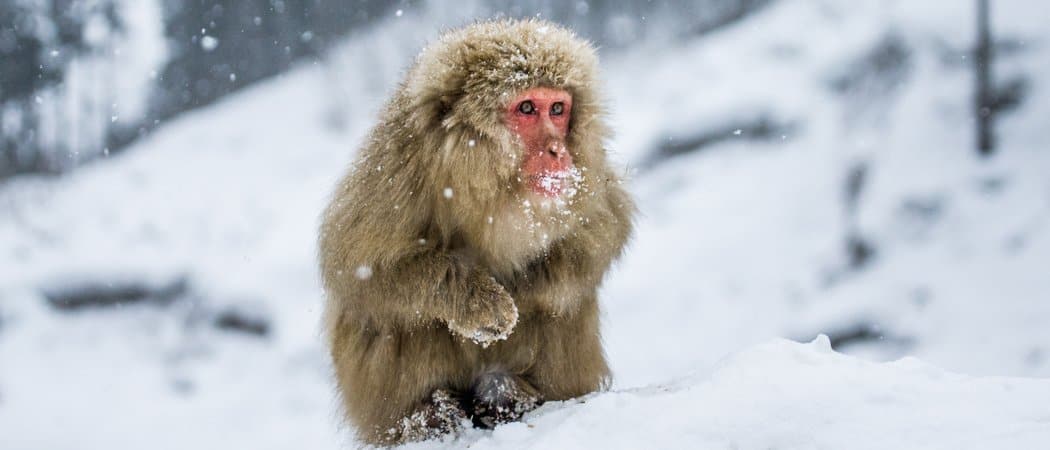
This is a Japanese macaque, one of 23 species in the genus
Macaca.
©GUDKOV ANDREY/Shutterstock.com
The scientific name of the macaque genus is Macaca. This is the feminine form of macaco, meaning the Portuguese word for monkey. They belong to the family of Old World monkeys, along with baboons, doucs, and mandrills.
There are 23 species in the macaque genus: the Barbary, lion-tailed, southern pig-tailed, northern pig-tailed, bonnet, assam, Tibetan, white-cheeked, arunachal, siberut, moor, booted, tonkean, Heck’s, gorontalo, Celebes crested, rhesus, Formosan, Japanese, crab-eating, stump-tailed, tocque, and Pagai Island macague.
Humans and macaques share approximately 93% of their DNA with each other (compared to 98.8% with chimpanzees). Humans last shared a common ancestor with macaques some 25 million years ago. This is essentially when the primate lineage split off. One group led to modern monkeys, whereas the other group led to modern great apes like us.
Appearance

Macaques have differences in manes, tails, and crests, like this Celebes crested macaque.
©Sergey Uryadnikov/Shutterstock.com
The macaque is a medium-sized monkey, generally measuring up to 28 inches and 40 pounds in size, with a somewhat long, rounded muzzle and nostrils located on the upper surface. The males are generally a lot larger than females, but otherwise, it can be difficult to tell them apart. The fur is usually some shade of brown or even black and thins out around the facial area. The arms are nearly the same size as the legs, making it easier to climb in trees.
Despite these similarities, each species has its own unique characteristics. The lion-tailed macaque, for instance, has a massive white mane of hair surrounding its face, whereas the Celebes crested macaque has a black crest of hair on the top of the head, almost like a mohawk (this species was the subject of the famous smiling monkey selfie photo). The tail is another characteristic that varies widely; some species have exceptionally long tails, whereas in other species it’s entirely absent.
Behavior
The primary social unit of the macaque is the troop. Composed of several females, a few males, and their offspring (ultimately totaling a few dozen or even more than a hundred individuals), these troops are primarily defined by dominance hierarchies. The females generally form strong and long-lasting matrilineal hierarchies in which the dominance rankings are passed down from mother to daughter. The males also have a separate dominance ranking based mostly on strength, but it tends to shift more frequently as the males come and go from the troop. Young males in particular that don’t belong to any particular troop may form their own separate bachelor groups.
The hierarchy is extremely important because higher-ranked members have better access to food sources and mates. Group cohesion is generally maintained through familiar activities such as grooming. Physical contact is also a good way to reduce stress after a bad encounter. Females are more likely to groom each other, but males will also groom females in the mating season.
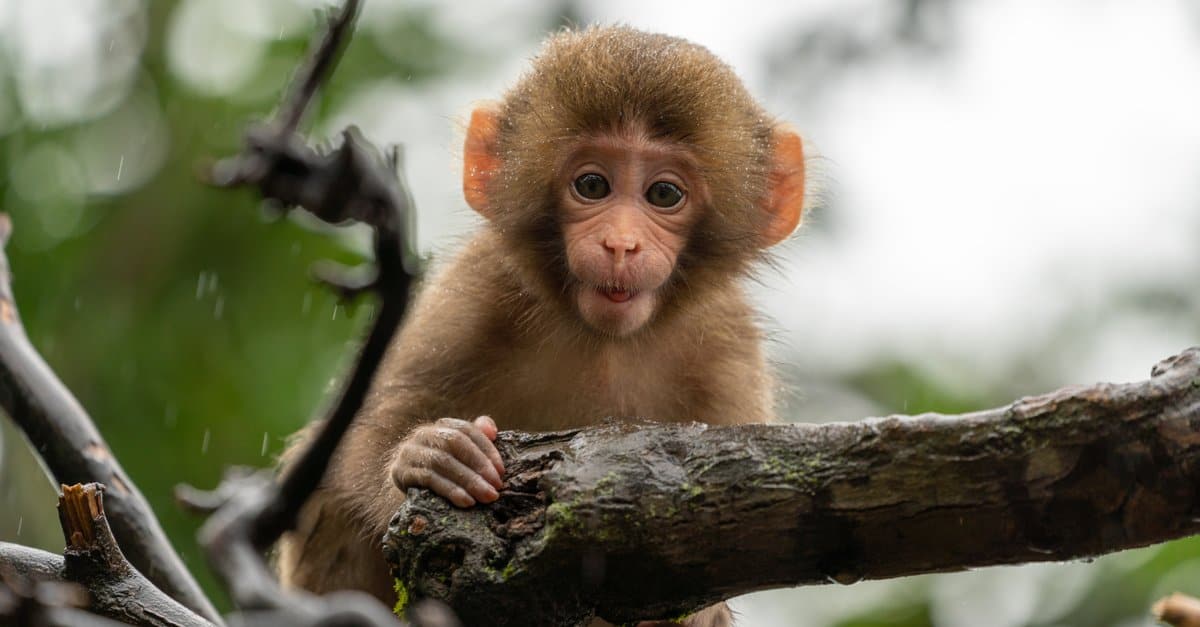
The Macaques are one of several non-human primates that build things like humans do.
©exs_yori/Shutterstock.com
There are numerous ways macaques communicate their moods and intentions with each other. An open-mouthed glare with a loud bark or screech conveys threat or aggression. This may be accompanied by branch shaking, lunging, or slapping the ground. Tail-up may indicate alertness or sexual presentation. Grunts, coos, and whimpers are all part of their verbal repertoire as well. In short, their behavior is incredibly complex and interesting.
As a relative of modern humans, it’s no surprise that macaques are some of the cleverest animals on the planet. There are reports that crab-eating macaques use stone tools to open up nuts and shells. They also wash their food in the water to clean it. Some macaques in popular tourist destinations will steal food right from the hands of people, or they’ll steal objects and barter for tasty treats. In the wild, macaques spend a good deal of their time in the trees, searching for food and looking out for predators, but they also are equally as comfortable on the ground. They are great climbers, good runners, and even quite adept at swimming.
Habitat
Macaques are highly adaptable animals that live in a variety of different habitats, including urban settings next to people. Most are primarily found in tropical rainforests, mountains, or plains throughout Asia, but a single species, the Barbary macaque, is located in North Africa as well. The highest concentration of macaques (with some seven species) is found on the Indonesian island of Sulawesi. Other species live in Taiwan, Japan, India, China, and Southeast Asia.
Predators and Threats
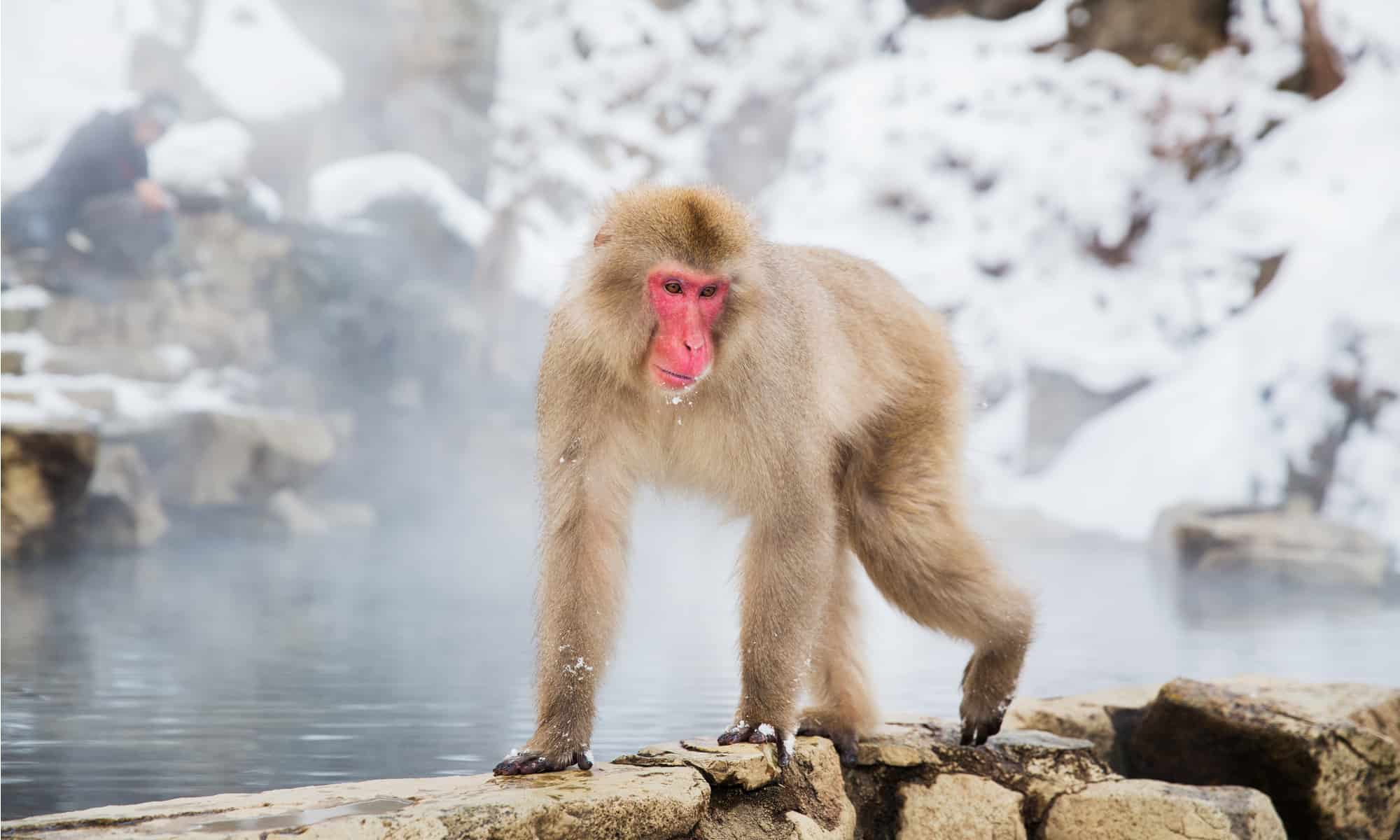
The Macaque diet consists mostly of fruit, but also seeds, leaves, flowers, and tree bark.
©Syda Productions/Shutterstock.com
These primates are facing enormous challenges from humans in the wild, including habitat loss and poaching. While they are capable of adapting to human-caused changes, many species cannot survive having their natural habitats fragmented and destroyed by farms, plantations, and towns.
The macaque has only a few predators in the wild, including tigers, crocodiles, snakes, leopards, and birds of prey. They can run into the trees and even mob predators for protection.
Macaques are primarily herbivores; their diet consists mostly of fruit, but also seeds, leaves, flowers, and tree bark. They will sometimes supplement this with insects, but this is uncommon. When living next to people, they can become a nuisance by raiding agricultural crops such as bananas, tomatoes, and mangos. They also like to receive free food from people in popular tourist destinations. There are reports that macaques will steal valuable objects from people (such as glasses, jewelry, or shoes) that they then barter for food. Sometimes they will only accept food with the highest nutritional value.
Reproduction and Life Cycle
Macaques are promiscuous breeders within their group. They generally mate with whomever they want throughout the year. Higher ranked females typically mate more often and give the baby better access to food. Every year or two the female will give birth to a single offspring after a gestation period lasting five to six months long.
The young baby will begin to consume solid foods at about two weeks after birth, but it may take more than a year to wean the baby fully from the mother’s milk. They develop important social skills by playing with other infants in the troop. The juvenile still remains close to and dependent on its mother until the birth of a sibling. By 18 months, they will finally start to consume the same foods as an adult.
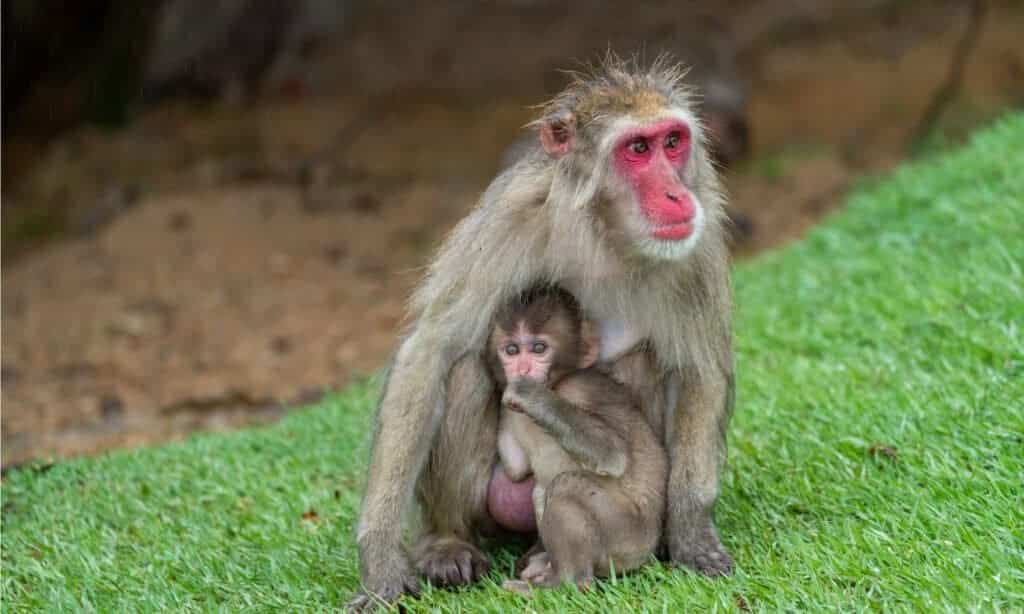
Macaque females reach maturity after three or four years and give birth every year or two to a single offspring.
©exs_yori/Shutterstock.com
Females generally stay with the troop of their birth; they reach sexual maturity after about three or four years. Males, on the other hand, leave their original troop to find a new one. Many young males end up in bachelor groups until they’re old enough to join a larger troop. They can take up to seven years to reach maturity.
The average lifespan of a wild macaque is less than 15 years, partly due to disease and predation, but captive macaques can live more than 25 years old. As macaques start to reach old age, they develop many of the same health problems as humans, including arthritis, cataracts, diabetes, and obesity. Females generally start to go through menopause at 25 years of age. The maximum recorded lifespan was about 40 years old in captivity.
Population
According to the IUCN Red list, many macaques are threatened with extinction. For instance, the endangered lion-tailed macaque of India is thought to have only about 2,500 individuals remaining. It is ranked as one of the most threatened primates in the world. Only the Japanese macaque and the Rhesus monkey are classified as species of least concern. Conservation efforts have focused on maintaining their existing habitat in the wild. This usually involves working with local governments and individuals to make sure the macaques have enough space to roam and feed.
View all 164 animals that start with MMacaque FAQs (Frequently Asked Questions)
Is the macaque carnivorous, herbivorous, or omnivorous?
The macaque is largely herbivorous (in some parts of its range, it eats mostly fruit), but it does consume some insects as well.
Are macaques good pets?
They do not make good pets. These are wild animals that would require specialized care. They require massive outdoor play areas and proper housing, plus they need to have regular contact with other members of their species. If they do not have their social and physical needs met, then macaque monkeys can become bored, angry, aggressive, and depressed. This is bad for both the owner and the pet.
Is a macaque a monkey?
Yes, it is considered to be a member of the Old World monkey family.
Why are macaques so aggressive?
If the macaque has grown accustomed to the presence of humans, then it generally isn’t too aggressive. But keep in mind these are wild animals with wild instincts. They can be a little skittish and territorial around other species or non-troop members.
What is the difference between a monkey and a macaque?
The macaque is a type of monkey (generally meaning all primates except for apes).
What is the proper pronunciation of macaque?
The pronunciation is like muh-kak. This means the pronunciation of the “C” and the “Q” would both be a hard “K” sound.
Where can I buy a macaque?
It is illegal to own monkeys in many states and countries around the world. And even in places where it is legal, it is not a good idea to own one, because it would be almost impossible to replicate their natural behavior in captivity. It is better to admire them from afar in zoos or nature conservatories where they’re well cared for.
Thank you for reading! Have some feedback for us? Contact the AZ Animals editorial team.
Sources
- , Available here: https://www.britannica.com/animal/macaque
- , Available here: https://www.nc3rs.org.uk/macaques/macaques/life-history-and-diet/
- , Available here: https://wkar.pbslearningmedia.org/resource/nat16.sci.lisci.macaque/learned-behavior-and-culture-in-thieving-macaque-monkeys/

